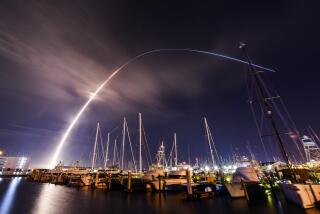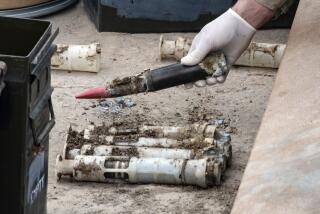Suit Alleging Plutonium Danger Will Seek to Block Shuttle Launch
- Share via
NASA’s long-delayed shuttle launch of the Galileo mission to Jupiter, already several years behind schedule because of the Challenger disaster, now faces a legal battle that could jeopardize next month’s scheduled launch.
A Washington-based public interest law firm, the Christic Institute, and several other organizations plan to file suit today in Washington in an effort to block the launch. The suit--which climaxes several months of growing concern over the safety of the launch--will argue that the launch will endanger the public because an accident could release 48 pounds of highly radioactive plutonium 238 carried aboard Galileo.
The plutonium is used to generate electric power to run Galileo’s many components.
“We thought it was a terrible idea” to launch the shuttle Atlantis with Galileo and its radioactive generators in its cargo bay, said Lanny Sinkin, an attorney with the institute. National Aeronautics and Space Administration officials have said the plutonium is packaged in such a way that even an explosion like the one that destroyed Challenger would not likely release significant amounts of the deadly substance, but Sinkin believes the risk is just too great.
The battle promises to be a bitter one, and it has even divided the community that would normally be expected to stand united against a launch carrying radioactive materials.
“After going through mountains of material and soul-searching, I am comfortable with the launch,” said Steven Aftergood, senior research analyst with the Federation of American Scientists. Aftergood, who has led the fight to block the use of orbiting nuclear reactors, has personally watched some of the many tests that NASA has used to evaluate the safety of the generators. He said he is “persuaded that the safety risks are small and the scientific payoffs are large.”
“I hope to see it go forward,” he said.
“We believe it is safe or we wouldn’t propose to launch,” said John Casani, longtime manager of the Galileo program and now a top executive with NASA’s Jet Propulsion Laboratory in Pasadena.
Donald Williams, who will command the Atlantis, said he isn’t worried.
“We really have looked at this quite a lot, and I’m convinced in my own mind that it’s absolutely safe to fly,” Williams said at a recent Florida press conference.
Others, however, are not convinced.
“After the Challenger explosion, Chernobyl and the Valdez accident, we have learned that technology can go terribly wrong,” Bruce Gagnon of the Florida Coalition for Peace and Justice said. The coalition is expected to be a party to the suit.
The suit will challenge the adequacy of NASA’s environmental impact report, which declares the risk minimal. A federal interagency panel, however, does not rule out the possibility that some cancer deaths could occur if the plutonium is somehow pulverized and released into the environment.
The Atlantis is scheduled for launch Oct. 12. If the suit delays the launch past Nov. 24, the mission will have to be postponed for 18 months because it will be that long before the planets are aligned in a way that would make the encounter possible.
Earlier this month the White House Office of Science and Technology formally approved the launch, setting the stage for the coming legal skirmish.
NASA’s opposition has been motivated partly by the space agency’s lack of credibility in the field of risk-benefit analysis, as demonstrated by the Challenger disaster, and partly by defection by some respected members of the space community. Richard Cuddihy, a radiation expert and a member of the panel that recommended that the White House give its required approval for the launch, has filed a minority report claiming that the launch “puts a large number of people at risk.”
“Our real bottom line is, go find an alternative to the plutonium,” Sinkin said.
But NASA and independent experts contend that there is no alternative. Galileo, like 22 other space probes launched with radioactive generators, will operate in areas so far from the sun that solar energy is not practicable.
Galileo will have two “radioisotope thermoelectric generators,” each powered by 24 pounds of plutonium 238. As it decays, the plutonium gives off heat that is converted directly to electricity.
The same type of power plant was used aboard the Voyager 2 spacecraft, which recently capped a 12-year tour of four outer planets last month when it zipped past Neptune.
But unlike all the other space probes with nuclear generators, Galileo is to be the first launched by the shuttle. The fight to block the launch is fueled largely by memories of the Challenger fireball over the Florida coast four years ago.
Although 22 spacecraft using a total of 38 radioisotope generators have been launched, the record is not without its blemishes.
A U.S. navigational satellite failed to reach orbit April 21, 1964, and its power supply disintegrated in the atmosphere “as it was designed to do in case of re-entry,” Aftergood noted in a position paper on Galileo. The accident “tripled the worldwide inventory” of plutonium 238 and “increased the total world environmental burden from all plutonium isotopes by about 4%.” A federal report predicted that six fatal cancers would develop as a result of that accident.
NASA maintains, however, that it has taken great precautions with the Galileo probe, significantly reducing any risk to the public.
Plutonium is most dangerous when it is in the form of a fine powder because it is most harmful when it is inhaled. Once inhaled, a single particle can produce fatal cancer by irradiating nearby cells.
To reduce that danger, the plutonium carried aboard Galileo is in 72 solid fuel pellets encased in metal. The fuel itself is in a ceramic form, so even if the generator is destroyed the debris should consist mainly of larger particles that if ingested by humans will tend to be excreted, safety officials maintain.
On behalf of the space agency, the federal Department of Energy has subjected generators to pressures up to 2,200 pounds per square inch, although the maximum explosion in the Challenger has been estimated at 400 pounds per square inch, and the coating that surrounds the pellets remained intact, according to the agency.
The generators have been shot with bullets made of material that would simulate fragments from various shuttle components. They have been exposed to intense fire for up to 10 minutes and slammed into steel and concrete.
The tests show that under some circumstances, some fuel would be released, so the space agency’s own findings do not rule out the possibility of some hazard in the event of a major accident. NASA has maintained that the risk is extremely low, and even an explosion on the launch pad would release only enough radiation to cause “0.7 fatalities.”
However, a federal Interagency Nuclear Safety Review Panel found NASA’s estimates too low and concluded that a launch accident could result in 80 fatal cancers.
But the greatest risk could come months after a successful launch.
The space probe’s solid-fuel rocket propulsion system is not powerful enough for Galileo to fly directly to Jupiter, so the spacecraft will fly first to Venus and then pass by the Earth twice, using the two planets’ gravitational fields to boost its speed so that it can venture far out into the solar system.
The second near-Earth encounter will bring the probe within 200 miles of the surface, and if the craft should somehow re-enter the Earth’s atmosphere and break up in a fireball, more plutonium could be released in a more hazardous powdery form than even a massive explosion on the launch pad.
The interagency panel estimated that an accidental re-entry into the Earth’s atmosphere could produce from zero to 2,000 cancer fatalities.
More to Read
Sign up for Essential California
The most important California stories and recommendations in your inbox every morning.
You may occasionally receive promotional content from the Los Angeles Times.













